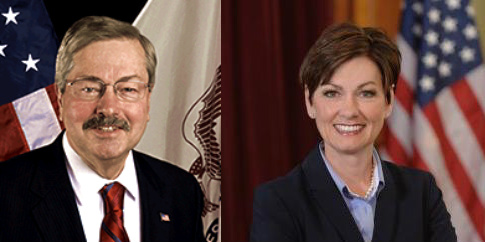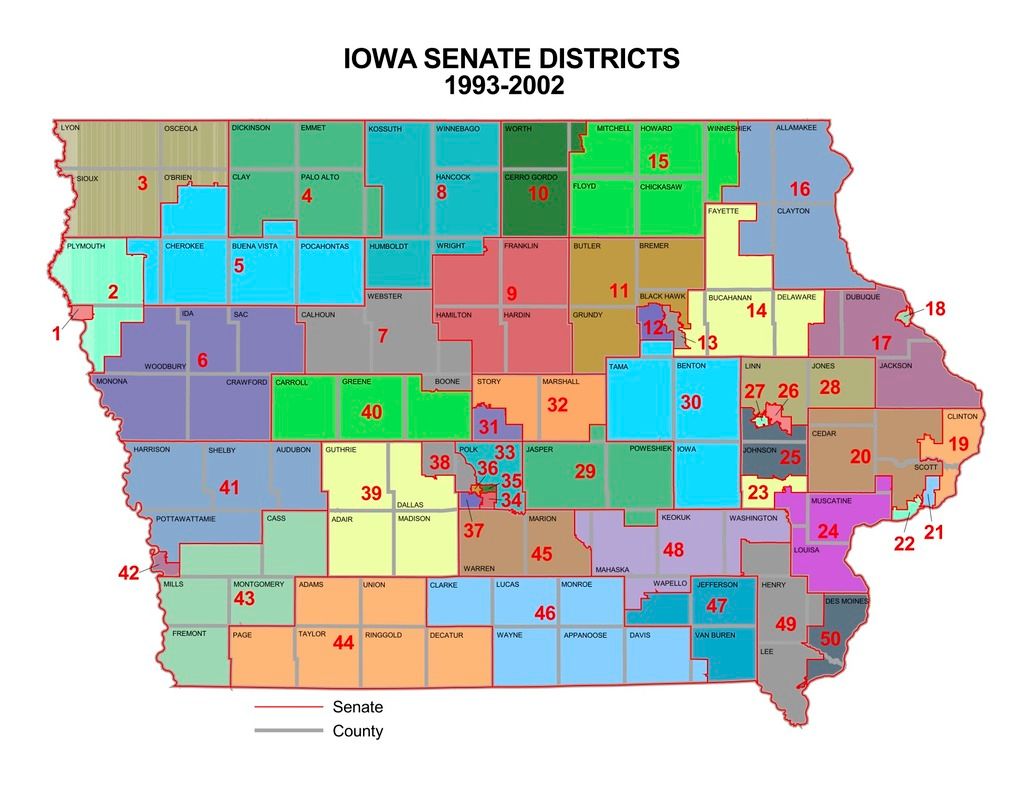Terry Branstad passed over some better-known and better-connected Republicans when he picked State Senator Kim Reynolds to be his running mate in 2010. During that campaign, Branstad said he was looking for a lieutenant governor who could take his place. He made clear on many subsequent occasions that he was “grooming” Reynolds. The plan will come to fruition after Branstad is confirmed as U.S. ambassador to China.
Few Iowans outside Clarke County had heard of Reynolds in June 2010, but Branstad had taken an interest in her political career long before then. If his original plan had worked out, Reynolds would have been elected to the Iowa Senate for the first time on this day in 1999.
This story begins in 1996. Democratic State Senator Patty Judge was up for re-election in a district covering six counties and a sliver of a seventh in south-central Iowa (see map below). Then Senate Minority Leader Jack Rife recruited Wayne County farmer Claude Neill to run against Judge. Speaking by phone last month, Neill recalled rumors that some Republicans were sounding out Kim Reynolds for the race. She was then in the middle of her first term as Clarke County treasurer, and Branstad had appointed her to the Iowa Public Employees Retirement System board. In the end, no other candidate filed for the GOP primary to represent Senate district 46.
Though he was a “novice” candidate who “got trounced” by Judge, losing by about 5,000 votes, Neill enjoyed his first campaign experience.
When I talked to Rife, he spoke highly of Neill and said he’d been “very upset” when the GOP didn’t follow through with spending they had promised to support his 1996 campaign. A hot political topic at the time was “local control,” meaning county-level regulation of agricultural enterprises. Branstad had signed a 1995 law that prohibited counties from restricting the size of livestock operations, paving the way for explosive growth of confined animal feeding operations (CAFOs). Judge had voted for that bill, whereas Neill had spoken out against Jack DeCoster‘s hog lots in southern Iowa.
Rife said Branstad was aware of Neill’s position on local control. He believes the governor’s allies in Republican circles had a hand in calling back a person en route to deliver money to Neill’s campaign.
Judge didn’t serve out her second term in the Senate, because in 1998 she ran successfully for Iowa Secretary of Agriculture. Her resignation from the state legislature led to a special election set for January 12, 1999. Neill “immediately announced” plans to seek the GOP nomination, then went on a brief planned vacation. When he returned, a letter from the governor was waiting for him, encouraging county central committee members to support Reynolds for the Senate vacancy.
Multiple sources remembered that Branstad wrote to every GOP central committee member in the counties that would select a Senate nominee. Jeff Angelo, who represented the state Senate district next door during the 1990s, told me Branstad’s people “had their eye on Kim for a really, really long time.”
Longtime Clarke County GOP chair Ray Negley remembered Reynolds actively campaigning for the seat, traveling to talk to other central committees before the special nominating convention. As one would expect, Clarke County Republicans strongly supported their hometown candidate. (Neill’s stance against a casino boat in Osceola wouldn’t have been popular with them either.)
Negley commented that Neill went into the special election race with higher name recognition around the district, thanks to his campaign against Judge two years before. Neill told me he spent hours calling roughly 170 Republicans who would have a vote at the nominating convention–“my phone bill was horrendous.” He said he didn’t make an issue out of Branstad’s intervention on behalf of Reynolds. I would guess that some local activists resented the interference from party leaders. Similar sentiment was a factor when the governor’s preferred candidate lost the district nominating convention before a critically important Iowa Senate special election in 2011.
Rife acknowledged there “might have been” a proxy war dynamic at play during the Senate district 46 special election campaign. Rife had endorsed then U.S. Representative Fred Grandy in the 1994 GOP gubernatorial race. Branstad barely won that primary with less than 52 percent of the vote. Though he went on to win a fourth term easily, many old hands attest to the governor’s long memory when it came to pols who had favored Grandy.
Rife was no longer in Senate leadership in 1998. His GOP colleagues had chosen Stew Iverson to lead their caucus after winning back the Senate majority in 1996. Nevertheless, Rife had recruited Neill, who was crosswise with the governor on a highly salient agricultural policy issue. And as Angelo said, Branstad’s people saw potential in Reynolds.
Delegates to the nominating convention picked Neill to face off against Democratic candidate John Judge, Patty’s husband. It was the first–and so far the only–political defeat for Reynolds. Sources told me she did not formally endorse Neill before the special election. (Reynolds did not respond to multiple interview requests, so I was unable to hear her side of the story.)
Rife didn’t recall being very involved in Neill’s 1998 campaign, but he had the impression that GOP leaders “left him hanging” against John Judge, as they had done in 1996 when he ran against Patty Judge. Republicans didn’t need that Senate seat to build a majority.
Judge defeated Neill on January 12, 1999 by just 117 votes (4,494 to 4,377). He lost a 2000 re-election bid to Paul McKinley.
Rife’s 18-year career in the Iowa Senate ended when Tom Fiegen defeated him in 2000. He has since worked in the family cattle business.
Reynolds carried on as Clarke County treasurer until 2008, when Angelo recruited her to run for the Senate seat he was vacating. The new Iowa map following the 2000 census had separated Clarke County from most of the old Senate district 46.
Statehouse Republicans were at a low point when Reynolds was first elected. Democrats controlled the governor’s office and both the Iowa House and Senate. Reynolds didn’t attract much attention as a new member of a GOP caucus with just 18 senators. Still, her legislative experience made her a better prospect to be Branstad’s running mate in 2010 than if she had remained an elected official in one small county.
As they say, the rest is history.



1 Comment
So what does she have on him?
Or is it that she is just so mindless that she fits the Stepford Profile just like Senator Joni “Battered Spouse Syndrome” Ernst?
dmnative Sat 14 Jan 5:24 PM